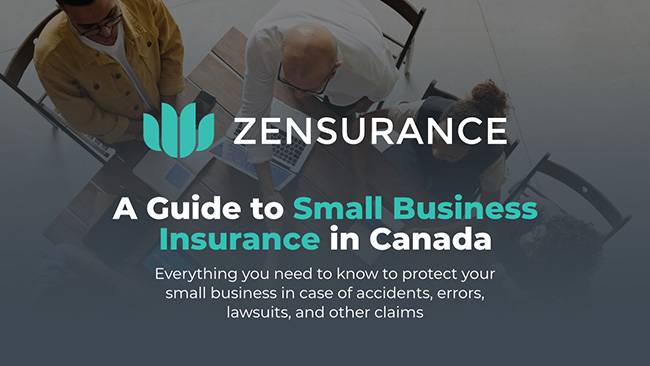As the summer fades in the rearview mirror, it’s crucial for every business vehicle owner to proactively prepare their wheels for the impending wet and wintry weather.
Preparing your ride for the fall and winter can increase its reliability and performance during harsh weather conditions. Icy roads, freezing temperatures, and reduced visibility while behind the wheel increase the risk of accidents and breakdowns.
Getting your ride ready for what’s to come cannot only help keep your commercial auto insurance premium low but also reduce the possibility of being involved in an accident, saving you potential repair and replacement costs.

Download Our FREE Insurance Guide
Learn everything you need to protect your small business.
Whitepaper download
"*" indicates required fields
Your email address will be used by Zensurance to provide latest news, offers and tips.
You can unsubscribe at any time.

10 Tips for Getting Your Business Vehicle Ready for Fall and Winter
We recommend you get your business vehicle serviced by a certified automotive technician. Regardless, here are 10 things you can do to ensure your car, SUV, pickup, or van is ready for the wintry road ahead:
1. Inspect Belts and Hoses
If the belts or hoses under the hood are cracked, fraying, worn out, or leaking, replace them. Failing belts and hoses can lead to engine failure or damage and potentially leave you stranded at the side of the road.
2. Check All Fluid Levels
Ensure all the fluids in your vehicle are topped up. Check the windshield washer fluid and use washer fluid designed for the winter. Also, check the brake, coolant, power steering, and transmission fluids to ensure they’re at the appropriate levels.
3. Get Winter Tires Installed
From November 1 to April 30 (when temperatures are consistently below +7 degrees C), it’s recommended to have winter tires installed on any vehicle. Not only can you earn a modest discount on our commercial auto insurance for doing so, but more importantly, winter tires increase your vehicle’s traction on wet, snowy, icy roads and are more effective than all-season tires. Having an auto technician also check the vehicle’s wheel alignment when swapping your tires is worthwhile.
According to the Traffic Injury Research Foundation, winter tires have better traction at minus-30 degrees C than all-season tires do at +4 degrees C, and a vehicle with winter tires on an icy road needs 6.4 metres to come to a complete stop compared to 12.1 metres for a vehicle with all-season tires.
4. Get an Oil and Filter Change
Getting an oil and filter change at routine intervals, as your vehicle manufacturer recommends, helps ensure your vehicle will run smoothly and burn less fuel. Regular oil and filter changes can also help extend the longevity of your car or truck.
5. Hold On! Check the Brakes
A brake inspection is necessary for any vehicle at least twice a year – before and after winter. Colder weather conditions can have a detrimental impact on your braking system, and road salt and moisture can erode the components and reduce their efficiency.
6. Pack a Winter Driving Emergency Kit
You never know if a heavy snowfall will result in being stuck in the middle of nowhere. Be ready for such a possibility by having a roadside emergency kit in your vehicle. At a minimum, that kit should include a pair of gloves, extra washer fluid, a flashlight and spare batteries, battery jumper cables, a first aid kit, an ice scraper, and a warm blanket.
While you’re at it, it’s a smart idea to have a well-stocked emergency kit stored at your business property.
7. Test the Vehicle’s Battery
Have a close look at your vehicle’s battery. If you see signs of corrosion, it might be time for a new battery. Most vehicle batteries last for about five years. To test the battery’s charge, we recommend visiting an auto technician to inspect and test it.
8. Inspect the Vehicle’s Lighting System
Light ‘em up and walk around your vehicle to ensure your headlights, high beams, signal, tail, and brake lights are working. If you spot a burnt-out bulb, replace it. Being seen and being able to see clearly in inclement weather requires your vehicle’s lighting system to be in good condition.
9. Install New Wiper Blades
It’s wise to replace your windshield wipers before the winter. Generally, wiper blades should be replaced twice annually to ensure optimal performance and good visibility. If your wiper blades show signs of cracks, make squeaking or scraping noises when in use, or leave streaks across the windshield, it’s time to replace them.
10. Review Your Commercial Auto Insurance
If you already have a commercial auto insurance policy, it never hurts to review it to ensure you have adequate coverage levels and optional vehicle coverages in your policy (like collision and comprehensive vehicle coverages). A Zensurance broker can help review your policy and make recommendations for upping your protection if you need it.
Tips for Driving Safely in Wet and Winter Conditions
Driving in dark, slick, or wintry conditions can be more demanding than driving in the summertime. Here are a few tips to help avoid getting into an accident:
- Keep a safe distance from other vehicles in front of you. Slick and slippery roads make stopping quickly challenging, even if you have winter tires installed. So, allow extra space between your vehicle and others to give yourself enough time to stop suddenly if necessary.
- Drive defensively and avoid sudden actions, such as braking and accelerating. Also, always use your signals whenever making turns or changing lanes and check your blindspots before turning or changing lanes.
- Don’t be a distracted driver. Focus on driving, not fidgeting with a mobile device, GPS system, or your vehicle’s infotainment system. Convictions of major driving offences, such as dangerous driving, excessive speeding, impaired driving, careless driving, and distracted driving, can significantly spike your commercial auto insurance premium or even lead to an insurer cancelling your policy.
- Turn on headlights in rainy, snowy, or foggy weather. Whether daytime or nighttime, turn on your headlights when weather conditions are poor so other drivers and pedestrians can see you.
- Clear your vehicle’s sensors and rear camera from dirt, grime, snow, and ice to ensure they work properly.
- If the weather suddenly turns bad – a blizzard, extreme rainfall, dense fog – turn on your hazard lights and pull over to a safe spot to park and wait it out. Avoid stopping or parking on the side of a road or highway. Instead, look for a nearby service station or parking lot.
Get Low-Cost Commercial Auto Insurance and Protect Your Ride
Although commercial auto insurance isn’t a maintenance contract, it’s vital to have if you get into a collision (and it’s required by law). But it isn’t just a matter of getting any type of commercial auto insurance, but the right type that suits your needs.
Zensurance can help with that. Fill out our online application for a free quote in less than five minutes, and let us rev your engines with a low-cost commercial auto policy.
Our knowledgeable brokers will shop the market for you and customize your policy to suit your needs and budget.
Related Posts
10 Tips for Closing Your Small Business for the Winter
Are you closing up shop for the winter? Ensuring your property is prepared for winter and your valuable contents and inventory are safely stored is vital. See our tips for how small business owners can shut down operations and keep their assets safe.
9 Ways to Celebrate Small Business Saturday in Canada
Take advantage of Small Business Saturday to raise brand awareness and attract new customers as the holiday shopping season heats up. See our list of how you can do that cost-effectively.
10 Insurance Tips for Women Entrepreneurs
Navigating the complexities of acquiring the right type of liability insurance can be daunting for any entrepreneur in any industry. See our insurance tips for helping women-owned businesses and startups make informed decisions.
Sign Up for ZenMail
"*" indicates required fields








